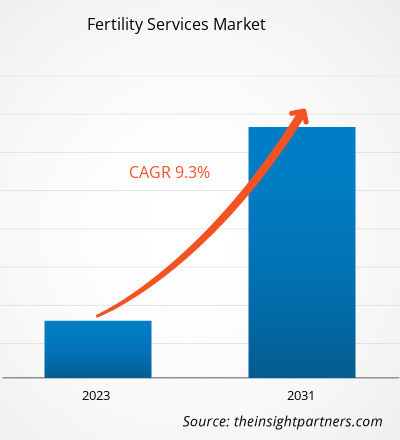[研究报告] 生育服务市场规模预计将从2023年的329.9亿美元增长到2031年的671.2亿美元;预计该市场在2023年至2031年期间的复合年增长率将达到9.3%。
市场洞察与分析师观点:
生育服务市场规模不断增长的因素包括:医疗设施的可及性和可用性不断提高;对于精子形态不良、活力低下和精子数量少的男性,使用ICSI进行体外受精(IVF)的成功率不断提高;以及医疗保健和研究支出的不断增加。此外,多囊卵巢综合征(PCOS)、子宫内膜结核和性传播疾病(STD)等导致不孕不育的疾病的患病率不断上升,也在推动市场增长。人们对不孕不育问题的认识不断提高,以及更便捷的医疗服务也增加了发达国家和新兴国家对这些服务的需求。近年来,不孕不育相关疾病病例的增加推动了全球市场的发展。其他促进市场增长的因素包括可支配收入的增加、医疗保险公司提供灵活的保险方案,以及通过电视和互联网门户网站增加生殖服务的广告和推广。此外,该报告还根据当前生育服务市场趋势(例如生育服务推出和获批数量的不断增长以及技术进步)展望了增长前景。
增长动力:
妇科疾病患病率上升推动市场增长
未经治疗的性传播疾病 (STI) 或失败的流产、产后败血症以及腹部/盆腔手术造成的输卵管异常(例如输卵管阻塞)可导致女性不孕。子宫内膜结核、多囊卵巢综合征 (PCOS) 和性传播疾病 (STD) 等可导致不孕的各种疾病的发病率不断上升,这推动了生育服务市场的扩张。根据 2022 年 8 月出版的《Cureus 期刊》,全球女性人口中 PCOS 的患病率估计在 4% 至 20% 之间。世界卫生组织 (WHO) 估计,2021 年全球有超过 1.16 亿女性(3.4%)患有多囊卵巢综合征 (PCOS)。此外,根据《柳叶刀》2020 年的一篇文章,中国患有多囊卵巢综合征的女性估计数量为 2400 万。因此,这一因素刺激了女性对体外受精 (IVF) 和各种辅助生殖技术 (ART) 的需求,从而推动了生育服务市场的增长。
自定义此报告以满足您的要求
您将免费获得任何报告的定制,包括本报告的部分内容,或国家级分析、Excel 数据包,以及为初创企业和大学提供超值优惠和折扣
生育服務市場: 战略洞察

- 获取本报告的主要市场趋势。这个免费样本将包括数据分析,从市场趋势到估计和预测。
您将免费获得任何报告的定制,包括本报告的部分内容,或国家级分析、Excel 数据包,以及为初创企业和大学提供超值优惠和折扣
生育服務市場: 战略洞察

- 获取本报告的主要市场趋势。这个免费样本将包括数据分析,从市场趋势到估计和预测。
报告细分和范围:
生育服务市场分析基于程序、患者类型、最终用户和地域。根据程序,市场细分为辅助生殖技术、人工授精和生育手术。根据患者类型,市场分为男性和女性。就最终用户而言,生育服务市场细分为生育中心、医院和外科诊所以及其他。
细分分析:
根据程序,生育服务市场细分为辅助生殖技术、人工授精和生育手术。辅助生殖技术在2023年占据了最大的市场份额。预计在2023年至2031年期间,该细分市场的复合年增长率最高。辅助生殖技术市场进一步细分为体外受精、卵胞浆内单精子注射和代孕。
按患者类型,生育服务市场分为男性和女性。2023年,女性细分市场的市场份额较大。然而,预计男性细分市场在预测期内的复合年增长率会更高。压力水平的增加、肥胖、吸烟和饮酒是导致男性不育的因素之一。此外,人们对生育服务的认识不断提高、研发支出不断增加、主要市场参与者推出产品的举措以及生活方式的改变,都推动了男性细分市场的增长。
就最终用户而言,生育服务市场细分为生育中心、医院和外科诊所等。 2023年,生育中心占据了最大的市场份额,预计在2023年至2031年期间将实现最高的复合年增长率。全球生育诊所数量的增加,加上技术的进步,推动了该细分市场的全球增长。此外,发达国家和新兴国家民众对不孕不育治疗的认知度正在迅速提高。这导致全球生育治疗诊所数量的增加,推动了该细分市场的全球增长。此外,能够治疗不孕不育的专业人员数量不断增加;可支配收入不断增长;印度、中国等发展中国家持牌生育诊所数量的激增也促进了生育中心市场的增长。
区域分析 - 生育服务市场:
生育服务市场报告的范围主要集中在北美(美国、加拿大和墨西哥)、欧洲(西班牙、英国、德国、法国、意大利和欧洲其他地区)、亚太地区(韩国、中国、印度、日本、澳大利亚和亚太其他地区)、中东和非洲(南非、沙特阿拉伯、阿联酋和中东和非洲其他地区)以及南美洲和中美洲(巴西、阿根廷和南美洲和中美洲其他地区)。 2023 年,由于多种不孕不育药物的推出和快速分销,以及不孕不育研究活动的增加,亚太地区占据了最大的市场份额。
2023 年,欧洲占据了第三大生育服务市场份额。该地区的市场分为德国、英国、意大利、西班牙、法国和欧洲其他地区。众多国内市场参与者和不孕不育发病率的上升是推动该地区市场增长的关键因素。德国是该地区市场的主要贡献者之一。欧洲拥有全球 40% 的 IVF 诊所,这已被证明是欧洲生育测试和治疗市场成功的关键因素。此外,该地区还吸引了全球领导者的大量投资。欧洲市场的整体前景光明,卓越的 IVF 技术吸引了私募股权投资者的大量投资。此外,DIY 测试增加了不孕不育测试和治疗的可及性,并有助于降低成本。预计这两个因素将为未来几年生育服务市场的增长带来丰厚的机会。
预计亚太地区的生育服务市场在 2021 年至 2031 年期间的复合年增长率将达到 XX%,为最快。亚太地区市场分为中国、日本、印度、澳大利亚、韩国和亚太地区其他地区。由于医疗旅游业的兴起和医疗基础设施的改善,中国市场正在增长,预计这将增加该地区对生育服务的采用。此外,市场参与者在开发各种生育服务方面的技术进步预计将推动该地区市场的增长。预计未来几年产品发布的增加和高科技生育服务审批的增加将推动区域市场的增长。由于该地区不孕不育率的上升、晚孕趋势、试管受精成功率的提高以及可支配收入的增长,预计亚太市场在预测期内将显着增长。试管婴儿 (IVF) 是帮助不孕不育人群(包括单亲妈妈、夫妇和 LGBT 群体)最常用的方法之一。此外,由于生育旅游的兴起,亚太地区的 IVF 治疗市场具有可持续发展的潜力。此外,预计市场增长将受到生育诊所数量增加和新兴地区扩张潜力的推动。
生育服务生育服务市场区域洞察
生育服务市场区域洞察
The Insight Partners 的分析师已详尽阐述了预测期内影响生育服务市场的区域趋势和因素。本节还讨论了北美、欧洲、亚太地区、中东和非洲以及南美和中美洲的生育服务市场细分和地域分布。
生育服务市场报告范围
| 报告属性 | 细节 |
|---|---|
| 市场规模 2023 | US$ 32.99 Billion |
| 市场规模 2023-2031 | 2023-2031 |
| 全球复合年增长率 (2023 - 2031) | 9.3% |
| 历史数据 | 2021-2023 |
| 预测期 | 2023-2031 |
| 涵盖的领域 |
By 程序
|
| 覆盖地区和国家 | 北美
|
| 市场领导者和主要公司简介 |
|
生育服务市场参与者密度:了解其对业务动态的影响
生育服务市场正在快速增长,这得益于终端用户需求的不断增长,而这些需求的驱动因素包括消费者偏好的不断变化、技术进步以及对产品优势的认知度不断提高。随着需求的增长,企业正在扩展其产品线,不断创新以满足消费者需求,并利用新兴趋势,从而进一步推动市场增长。

- 获取 生育服務市場 主要参与者概述
行业发展与未来机遇——生育服务市场:
根据生育服务市场领先企业的新闻稿,以下列出了一些举措:
- 2022年10月,Indira IVF与Maven Clinic合作,Maven Clinic是一家专注于女性和家庭健康的美国公司,借助基于远程医疗的虚拟诊所提供服务。此次合作旨在让印度的Maven会员能够通过Maven平台享受Indira IVF的高质量临床护理、其他福利以及最佳的虚拟家庭教育护理。 Indira IVF 是一家总部位于印度的专科不孕不育诊所连锁机构。
- 2022 年 8 月,Genea Fertility 成为澳大利亚犹太生育网络 (AJFN) 年度主要筹款活动的白金赞助商。
- 2021 年 12 月,领先的女性健康解决方案提供商 Cooper Surgical 以 16 亿美元收购了 Generate Life Sciences。此次收购将使 Cooper Surgical 提供更丰富的生育和妇产科中心选择。Generate Life Sciences 是一家总部位于美国的公司,为生育冷冻保存服务、生育治疗中心和新生儿干细胞储存提供捐赠的卵子和精子。
- 2021 年 7 月,全球辅助生殖技术 (ART) 研究提供商 Hamilton Throne Ltd. 收购了 IVFTECH ApS (IVFtech) 及其子公司 K4 Technology ApS。K4, IVFtech 致力于为辅助生殖技术 (ART) 提供大容量层流工作站和培养箱。收购成本为 800 万美元。
- 2021 年 5 月,辅助生殖服务 (ARS) 领域的全球领导者 Virtus Health 宣布与专注于慢性炎症的澳大利亚生物技术和数字健康公司 Drop Bio 建立战略合作,推动精准生育领域的进步。
- 2021 年 2 月,领先的女性健康解决方案提供商 Cooper Surgical 宣布与辅助生殖服务的全球领导者 Virtus Health 建立多年战略合作,以推动生育治疗的创新、数字化和进步。
- 2020 年 11 月,Ferring BV 和 Igenomix 建立了为期四年的研究合作关系,开发用于治疗受妊娠相关疾病影响患者的新型治疗产品。
竞争格局和关键公司 - 生育服务市场:
CooperSurgical, Inc.;Vitrolife;Cook Medical; Care Fertility、INVO Bioscience、Carolinas Fertility Institute、Genea Limited、Merck KgaA、LABOTECT GmbH 和 Monash IVF Group Limited 是生育服务市场报告中重点介绍的市场参与者。这些公司专注于新技术、现有产品的改进和地域扩张,以满足全球日益增长的消费者需求。
- 历史分析(2 年)、基准年、预测(7 年)及复合年增长率
- PEST和SWOT分析
- 市场规模、价值/数量 - 全球、区域、国家
- 行业和竞争格局
- Excel 数据集
近期报告
客户评价
购买理由
- 明智的决策
- 了解市场动态
- 竞争分析
- 客户洞察
- 市场预测
- 风险规避
- 战略规划
- 投资论证
- 识别新兴市场
- 优化营销策略
- 提升运营效率
- 顺应监管趋势




















 获取免费样品 - 生育服務市場
获取免费样品 - 生育服務市場